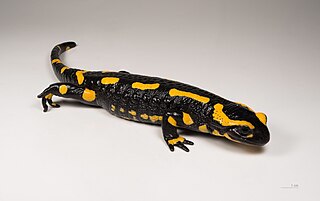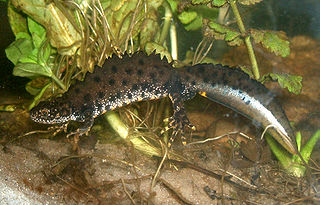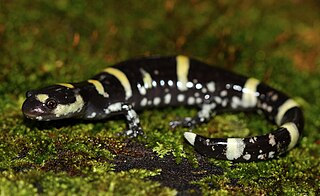
The smooth newt, European newt, northern smooth newt or common newt is a species of newt. It is widespread in Europe and parts of Asia, and has been introduced into Australia. Individuals are brown with a spotted underside that ranges in colour from orange to white. They reach an average length of 8–11 cm (3.1–4.3 in); males are larger than females. The newts' skins are dry and velvety when they are living on land, but become smooth when they migrate into the water to breed. Males develop a more vivid colour pattern and a conspicuous skin seam (crest) on their back when breeding.

The palmate newt is a species of newt found in Western Europe, from Great Britain to the northern Iberian peninsula. It is 5–9.5 cm (2.0–3.7 in) long and olive or brown with some dark spots. The underside is yellow to orange, and the throat, unlike in the similar smooth newt, always unspotted. A dark stripe runs along the head and through the eyes. Breeding males develop a distinct filament on the end of their tail, strongly webbed hind feet, and a low, smooth crest on their back.

The tiger salamander is a species of mole salamander and one of the largest terrestrial salamanders in North America.

The spotted salamander or yellow-spotted salamander is a mole salamander common in eastern United States and Canada. It is the state amphibian of Ohio and South Carolina. The species ranges from Nova Scotia, to Lake Superior, to southern Georgia and Texas. Its embryos have been found to have symbiotic algae living in and around them, the only known example of vertebrate cells hosting an endosymbiont microbe.

The spring peeper is a small chorus frog widespread throughout the eastern United States and Canada. It prefers permanent ponds due to its advantage in avoiding predation; however, it is very adaptable with respect to the habitat it can live in. In northern regions, the frog is able to endure below freezing temperatures due to the capacity of its liver to exude and flush the bloodstream with a glucose cryoprotectant which acts both as an anti-freeze in its blood, and allows organs like the heart to enter into a state of protected dormancy. The peeper earned its name from its chirping call, which marks the beginning of spring. Crucifer is derived from the Latin root meaning "cross-bearing", a reference to the cross-like pattern on the spring peeper's dorsal side.

The fire salamander is a common species of salamander found in Europe.

The California tiger salamander is a vulnerable amphibian native to California. It is a mole salamander. Previously considered to be a subspecies of the tiger salamander, the California tiger salamander was recently designated a separate species again. The California tiger salamander distinct population segment (DPS) in Sonoma County and the Santa Barbara County DPS are listed as federally endangered, while the Central California DPS is listed as federally threatened. The Sonoma County, south San Joaquin, and the Santa Barbara County DPS have diverged from the rest of the California tiger salamander populations for over one million years, since the Pleistocene and they may warrant status as separate species.

The northern crested newt, great crested newt or warty newt is a newt species native to Great Britain, northern and central continental Europe and parts of Western Siberia. It is a large newt, with females growing up to 16 cm (6.3 in) long. Its back and sides are dark brown, while the belly is yellow to orange with dark blotches. Males develop a conspicuous jagged crest on their back and tail during the breeding season.

Lithobates sylvaticus or Rana sylvatica, commonly known as the wood frog, is a frog species that has a broad distribution over North America, extending from the boreal forest of the north to the southern Appalachians, with several notable disjunct populations including lowland eastern North Carolina. The wood frog has garnered attention from biologists because of its freeze tolerance, relatively great degree of terrestrialism, interesting habitat associations, and relatively long-range movements.

The ringed salamander is a species of mole salamander native to hardwood and mixed hardwood-pine forested areas in and around the Ozark Plateau and Ouachita Mountains of Arkansas, Oklahoma, and Missouri. This species of salamander has slander body, small head, and long tail. They are usually found to have various dorsal color from dark gray to dark brown. Various close relatives are found such as marbled salamander and spotted salamander. This species of salamander has cannibal behavior especially those in large body size.

The long-toed salamander is a mole salamander in the family Ambystomatidae. This species, typically 4.1–8.9 cm (1.6–3.5 in) long when mature, is characterized by its mottled black, brown, and yellow pigmentation, and its long outer fourth toe on the hind limbs. Analysis of fossil records, genetics, and biogeography suggest A. macrodactylum and A. laterale are descended from a common ancestor that gained access to the western Cordillera with the loss of the mid-continental seaway toward the Paleocene.

The Santa Cruz long-toed salamander is an endangered subspecies of the long-toed salamander, which is found only close to a few isolated ponds in Santa Cruz and Monterey Counties in California. It has a black body, broken yellow or orange irregular striping along its spine, and a tail fin well evolved for swimming. Like other mole salamanders, it is found near pools or slow-moving streams and has a very secretive lifestyle, making it difficult to find.

The blunt-headed salamander is a mole salamander endemic to Mexico. It is only known from the vicinity of its type locality, near Morelia, in Michoacán state in Southwestern Mexico. It inhabits a landscape consisting of a mosaic of natural grasslands and pine-oak forests at elevations of about 2,000 m (6,600 ft) asl. Breeding takes place in ponds. An average adult has a mass of 6.18 grams while wet. Adult females of the species range from 42-93 mm and males range from 45.4-70.5 mm in standard length.

The small-mouth salamander is a species of mole salamander found in the central United States, from the Great Lakes region in Michigan to Nebraska, south to Texas, and east to Tennessee, with a population in Canada, in Pelee, Ontario. It is sometimes referred to as the Texas salamander, porphyry salamander, or the narrow-mouthed salamander. The Kelley's Island salamander was synonymized with A. texanum in 1995.

The Corsican brook salamander or Corsican mountain newt is a species of salamander in the family Salamandridae. It is endemic to Corsica, an island in the Mediterranean Sea.

The Caucasian salamander is a species of stream-dwelling salamander in the family Salamandridae. This is a salamander of medium size, with a thin, elongated body. It is a relict species, endemic to the south-western Caucasus, in Georgia and Turkey. The subspecies M. c. janashvilii is found at Mt. Mtirala near Batumi and probably along the Black Sea coast.

The Corsican fire salamander is a species of salamander in the family Salamandridae found only on the island of Corsica as an endemic species. In former times, this species was known as a subspecies of the widespread but continental-distributed fire salamander, which may appear quite similar.

The southern banded newt is a species of salamander in the family Salamandridae found in Armenia, Iraq, Israel, Jordan, Lebanon, Syria, and Turkey. This species has two subspecies - O. v. vittatus and O. v. ciliensis.

The Abe's salamander is a species of salamander in the family Hynobiidae. It is endemic to Japan and known from southwestern Honshu in northern parts of the Fukui, Kyoto, and Hyōgo Prefectures. The specific name abei honours professor Yoshio Abe, a Japanese zoologist.
The Shuicheng salamander is a species of salamander in the family Hynobiidae, endemic to China. Its type locality is Shuicheng in Guizhou Province, and it is not yet known from elsewhere; it is not likely to be widely distributed. It lives in a karstic region. The adults live on the forest floor near streams. Breeding takes places in pools, ponds, or near the springs, and the larvae develop in these habitats. It is threatened by habitat loss and pollution.























